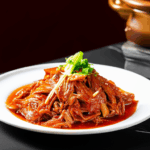- Introduction to Mapo Tofu
Mapo Tofu, or Ma Po Tofu, is a classic dish originating from the Sichuan province in China. It is renowned for its bold flavors and rich history. This iconic dish combines soft tofu with a spicy and savory sauce, creating a harmonious blend of textures and tastes that has captivated food enthusiasts worldwide.
Mapo Tofu is not just a meal; it’s an experience. The dish is characterized by its signature spicy and numbing flavors, achieved through the use of chili paste and Sichuan peppercorns. These ingredients give Mapo Tofu its unique kick, making it a favorite among those who appreciate robust, complex flavors. The dish also features minced pork or beef, which adds a layer of umami richness, complementing the softness of the tofu perfectly.
The name “Ma Po” translates to “pockmarked grandma,” referring to the dish’s inventor, an elderly woman known for her pockmarked face. Legend has it that she perfected this recipe in a small Sichuan town, and her culinary genius has since been immortalized in the form of this beloved dish. Today, Mapo Tofu is enjoyed globally, with variations that cater to different palates while still preserving the essence of its traditional roots.
This article will guide you through the process of preparing authentic Mapo Tofu, ensuring that you can recreate this iconic dish in your own kitchen. We’ll explore the essential ingredients, discuss cooking techniques, and provide tips for achieving the perfect balance of flavors. Additionally, we’ll delve into the cultural significance of Mapo Tofu, offering insights into why it remains such a cherished part of Sichuan cuisine.
- Ingredients
- Tofu: Soft tofu is the star of this dish. Look for firm but delicate pieces that will absorb the flavorful sauce without breaking apart. If you’re vegan, extra-firm tofu works well too.
- Minced Meat: Traditionally, minced pork is used, but minced beef can be substituted for added depth of flavor. For a vegetarian version, omit the meat entirely and enhance the sauce with mushrooms or soy protein.
- Sichuan Peppercorns: These tiny red berries are crucial for the signature numbing sensation. They should be toasted lightly before grinding to release their full aroma.
- Chili Bean Paste: Also known as Doubanjiang, this fermented bean paste is the backbone of the dish’s spiciness. It provides both heat and a savory, umami-rich flavor.
- Garlic and Ginger: These aromatics add layers of complexity to the dish. Fresh garlic cloves and ginger root should be finely chopped or minced.
- Vegetable Oil: Use high-smoke-point oil like peanut or vegetable oil to withstand the high temperatures needed for stir-frying.
- Seasonings: Salt, soy sauce, Shaoxing wine (or dry sherry), and sugar are used to balance the flavors. Be sure to adjust these according to your taste preferences.
- Starch Slurry: A mixture of cornstarch and water helps thicken the sauce and create a glossy finish.
- Garnishes: Finely chopped green onions, sesame oil, and a sprinkle of Sichuan peppercorns add final touches to the dish, enhancing both appearance and taste.
It’s important to note that the quality of each ingredient plays a significant role in the final outcome of the dish. High-quality tofu, fresh spices, and authentic chili bean paste are key to achieving the true flavor profile of Mapo Tofu.
- Cooking Techniques
Preparing Mapo Tofu involves several cooking techniques that contribute to its unique texture and flavor. Here’s a step-by-step guide to help you master the art of making this iconic dish:
- Preparation of Ingredients: Begin by draining and pressing the tofu to remove excess moisture. Slice it into cubes about 1 inch in size. Set aside. Next, prepare the minced meat by mixing it with a little salt, soy sauce, and Shaoxing wine. Let it sit for 10 minutes to marinate.
- Toast and Grind Sichuan Peppercorns: Heat a dry pan over medium heat and toast the Sichuan peppercorns until fragrant. Remove them from the pan and let them cool slightly before grinding them into a fine powder. This step enhances the numbing effect of the peppercorns.
- Make the Sauce: In a separate bowl, mix together the chili bean paste, soy sauce, sugar, and a bit of water to create a smooth sauce. This will serve as the base for the dish.
- Stir-Fry Minced Meat: Heat a wok or large skillet over high heat and add vegetable oil. Once the oil is hot, add the minced meat and stir-fry until it changes color and is fully cooked. Remove the meat from the pan and set it aside.
- Fry Garlic and Ginger: In the same pan, reduce the heat to medium and add more oil if necessary. Add the chopped garlic and ginger, stirring frequently until they become aromatic but not browned.
- Combine Tofu and Sauce: Carefully add the prepared tofu cubes to the pan, being mindful not to break them. Pour in the sauce mixture and stir gently to coat the tofu evenly. Let it simmer for a few minutes to allow the flavors to meld.
- Add Minced Meat and Thicken: Return the cooked minced meat to the pan and mix everything together. Gradually pour in the starch slurry, stirring continuously until the sauce reaches your desired consistency.
- Final Touches: Stir in the ground Sichuan peppercorns and garnish with chopped green onions and a drizzle of sesame oil. Serve immediately for the best flavor and texture.
Each step is crucial in ensuring that the dish maintains its integrity and delivers the authentic experience of eating Mapo Tofu. The careful handling of tofu, precise seasoning, and attention to detail in each stage of preparation all contribute to the final product’s success.
- Customization and Variations
While the traditional recipe for Mapo Tofu is highly respected, there are numerous ways to customize the dish to suit individual preferences or dietary restrictions. Here are some popular variations:
- Vegan Version: For those following a plant-based diet, simply omit the minced meat and enhance the dish with additional vegetables like bell peppers, carrots, or spinach. You can also increase the amount of tofu to make it more substantial.
- Lighter Option: To reduce the calorie content, you can use leaner cuts of meat or opt for tofu as the primary protein source. Additionally, using lower-fat cooking oils and reducing the amount of oil used for stir-frying can help lighten the dish.
- Spice Level Adjustment: Adjust the quantity of chili bean paste and Sichuan peppercorns based on your tolerance for heat and numbing sensations. Adding more or less of these ingredients allows you to tailor the dish to your preferred level of spiciness.
- Regional Adaptations: Different regions may have their own interpretations of Mapo Tofu. Some versions might include additional ingredients like bamboo shoots, mushrooms, or even seafood. Feel free to experiment with local ingredients to create a personalized version of the dish.
These variations showcase the versatility of Mapo Tofu, allowing it to be adapted to various tastes and dietary needs without losing its fundamental character.
- Cultural Significance
Mapo Tofu holds a special place in Chinese culinary culture, particularly within the Sichuan region. Its popularity extends beyond its borders, influencing global perceptions of Chinese cuisine. The dish is often featured in Chinese restaurants around the world, introducing diners to the vibrant and dynamic flavors of Sichuan cooking.
The cultural significance of Mapo Tofu lies in its ability to represent the essence of Sichuan cuisine. It embodies the region’s penchant for bold, contrasting flavors—spicy, salty, sweet, and numbing. This combination reflects the diverse and robust nature of Sichuan culture itself. Moreover, the story behind its creation adds a human element to the dish, connecting it to the legacy of a skilled home cook.
In recent years, Mapo Tofu has gained international recognition, appearing on menus at Michelin-starred restaurants and being featured in food festivals worldwide. Its widespread appeal is a testament to its universal appeal and the enduring fascination with authentic, flavorful dishes.
- Nutritional Benefits
Mapo Tofu is not only delicious but also nutritious. The soft tofu provides a good source of protein and calcium, while the inclusion of vegetables and lean meats adds vitamins and minerals. The dish is low in saturated fats and cholesterol, making it a heart-healthy option when prepared with minimal oil.
However, due to the high sodium content from soy sauce and chili bean paste, individuals with hypertension or other health conditions should consume Mapo Tofu in moderation. It’s advisable to choose reduced-sodium soy sauce or adjust the seasoning accordingly.
- Conclusion
Mapo Tofu is more than just a dish; it’s a cultural icon that encapsulates the spirit of Sichuan cuisine. By mastering the art of preparing this iconic dish, you not only gain a new culinary skill but also connect with the rich heritage of Chinese gastronomy. Whether you’re a seasoned chef or a beginner in the kitchen, the rewarding experience of crafting a perfect batch of Mapo Tofu is sure to leave a lasting impression.
Embrace the challenge, experiment with variations, and savor the bold flavors that make Mapo Tofu truly unforgettable. As you embark on this culinary journey, remember that the true essence of this dish lies in its balance of textures and flavors—a testament to the harmony between tradition and innovation in the world of cooking.

